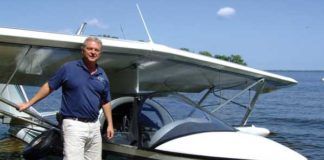In last months installment, we began a discussion of finishing tapes and how to apply them. Finishing tapes are required over any fabric seam and over wingribs after the fabric has been attached. They should also be placed on leading and trailing edges of surfaces, over the stringers on a fuselage and over any area exposed to wear or that may need additional reinforcement.
Now lets continue the discussion by outlining the methods required to attach inspection rings and drain grommets on a fabric surface.
Taping Curved Areas
Compound curves found on wingtips and tail surfaces are more easily taped using bias-cut tapes. These specially cut tapes will more readily conform to a curved surface than will linear or straight tapes. Remember two important points: A bias-cut tape has a seam about every 70 inches, and the tape will reduce in width about one-third when stretched around a curved area. So when you’re selecting the proper width of tape, remember to order a size wider to allow for the shrinkage. You will probably want at least a 4-inch-wide tape on a wingtip bow. That will allow you to begin on the leading edge of the wing and extend the tape around the bow, finishing with the proper width on the bow itself. You can actually overlap the bias tape on top of the leading-edge tape that is in place.
The first step is to cut the length of tape needed. Don’t forget the seams. Start your cut right after a seam. Cut the end that will be overlapped in the shape of a teardrop, as this will provide a more pleasing appearance. After cutting the tape, use a pencil (no pens) and carefully mark a centerline along its entire length. You can again mark the area where you will be applying the tape. Mark about a 3-inch width on the wingtip bow. Pre-coat this area with Poly-Brush that is thinned with one part of reducer to three parts of Poly-Brush. You will now attach the end of the bias tape cut in the shape of a teardrop over the leading edge tape that is in place. Apply Poly-Brush to a small area on the leading edge where you will overlap the tapes, and then apply the tape with Poly-Brush, holding it in place with a spring clamp or your fingers. Allow it to dry for a few minutes until it remains in place on its own.
The idea is to cement a small part of the bias tape in place, let it dry, and then come back after about an hour to complete the taping. You now have the tape held in place over about a 3-inch area, allowing you to apply tension to the tape. Next pull the tape around the wingtip, applying it to the entire bow. Use the pencil line to keep the tape centered over the bow. Keep pulling on the tape until all of the wrinkles are gone and the tape is in place. You now have a tape that has spanned a curved area without leaving any puckers or wrinkles.
Linear-cut tapes may also be pulled around curved areas if the curve is fairly shallow. Many people prefer using linear tapes because there are no seams to deal with. To use a linear tape, first attach the tape over a small area and allow it to dry. Then stretch the tape tightly around the curved area over a coat of Poly-Brush. You will probably end up with a few wrinkles and tape edges that are not cemented in place. You can then take an iron, calibrate it to 225 and use it to smooth out the wrinkles.
Again, bias tapes are more easily placed around a tight curve, but linear tapes may be used around normal curves of wingtips, etc. The choice is yours. I would suggest practicing on a curved part if at all possible before going to the actual part you are covering.
Heat Smoothing
This step makes the job look professional. When you are taping (linear or bias tapes) you will probably end up with a few wrinkles and raised edges on the tapes. These can be smoothed down and removed with the application of heat from an iron.
First, calibrate your iron to 225. A small hobby iron is best for this task. The Poly-Brush used to cement the tapes in place will begin to soften at about 200. (This step can be effectively accomplished only with the vinyl coatings used in the Poly-Fiber process.) This means you can use the iron to actually smooth out any imperfections that exist, particularly along the edges of tape. If you have pinked edges that are not cemented in place, you can use the tip of your iron to literally melt them down. This is much easier than sanding out imperfections.
You must be careful not to heat the iron to above 225. Anything hotter will shrink and deform your tapes, and you will then have tapes with a snakelike appearance. All wrinkles, bubbles and raised areas can be fixed using the iron as discussed. Go over every tape edge on the fabric surface. Use your fingers to tell when they are smooth enough. When they feel smooth to the touch, they will appear smooth in the final finish. This one step will save many hours of sanding later.
Inspection Access Rings
After you have covered your airplane you may have to gain access to certain areas inside the wings or the fuselage. This may be accomplished using plastic inspection rings. These hole reinforcements are cemented in place over every drag-wire junction, wing fitting, cable guide, control bell crank or over any other area that will need to be inspected regularly. Access may also have to be gained into one of these areas during assembly of the airplane. These inspection holes are usually installed on the bottom side of a surface. If you are re-covering an airplane, use the old fabric as a guide to locate placement of the inspection rings.
The plastic rings are cemented in place using Poly-Tak fabric cement. Use a small brush to apply a coat of Poly-Tak onto the ring itself and then lay it onto the fabric (flat side down) in the area desired. The fabric cement will dry within a few minutes. Be sure to clean up any cement that works out from under the ring using MEK.
After cementing the ring in place, you will then want to cover it using a piece of fabric. Failure to do this will provide an opportunity for the ring to separate from the base fabric at a later time. This separation is often the result of vibrations and air loads encountered when flying the airplane. A simple piece of fabric cut to fit over the ring will prevent this from occurring.
The first step in cutting a piece to fit over the ring is to smooth the fabric that will be used. You don’t want any wrinkles in it. Light weight fabric works best for this purpose. You can use an iron set at 250 and iron out all of the wrinkles on a piece of scrap fabric. Then take one of your 1-gallon cans and carefully set it on top of the piece of fabric. Take a pencil and draw a circle on the fabric using the outline of the can as a guide. This size is just about perfect to cover the inspection ring. You will want the fabric to extend beyond the ring itself. Cut the fabric with a pair of pinking shears. This will ensure you have pinked edges for proper cementing.
Using Poly-Brush that has been thinned appropriately, brush on a coat both inside and outside the inspection ring large enough to wet the fabric overlay. Set the piece of cut fabric over the ring and allow the Poly-Brush to soak through the fabric. Use a brush to work the Poly-Brush through the fabric. After it dries, brush on another coat of Poly-Brush. After this coat has thoroughly dried, you can use your iron to smooth out any imperfections.
When you have completed the airplane you may want to cut the fabric out of a few of these inspection rings. Cut out only those where access is needed for assembly of the airplane. Leave the others uncut. Those that remain can be opened at a later date if the need arises. Once the fabric inside the inspection ring is removed, it will be covered with a metal inspection plate. These plates are made to fit over the plastic inspection ring and are easily removed to provide access to the area.
Another tip: When you are painting your airplane be sure to paint a number of metal inspection plates the final finish color. You will then have them available to place on the inspection rings when needed at a later time.
Drain Grommets
Every fabric-covered airplane must have a way for moisture to escape. Condensation can introduce moisture, or rain or water from washing your airplane may leak into a wing or fuselage. These areas need to be able to breathe and allow moisture to escape. This is accomplished using drain grommets. These small grommets are cemented in place on the underneath side of surfaces. Any place where you think water may collect should have a grommet. Most wings, for example, will have a drain grommet located next to the outboard side of each rib at the trailing edge. Some people will place a grommet on each side of a rib. Obviously, you will want to place drain grommets on the underside of a fuselage to allow water to drain.
Drain grommets are cemented in place using Poly-Tak just like the inspection rings. They are then covered with a piece of fabric. They will vibrate loose if not covered with fabric. You can use a roll of fabric and draw a pencil mark on the fabric to be cut using the inside of the roll of fabric as a guide. This will provide the ideal size piece of fabric to cover a drain grommet. After you have completed the final finish, you can use a pencil soldering iron and melt the fabric out of the drain hole, which will allow water to drain out.
Three types of drain grommets are used: plastic, aluminum and seaplane grommets. I prefer to use aluminum grommets because they are thin and cover easily with a piece of fabric. Seaplane grommets feature a small vented hood that will help them siphon water out. They are normally reserved for use on seaplanes.
Fabric Gussets
There may be areas of the fabric that need to be reinforced where a finishing tape is not satisfactory. The area may be oddly shaped or too large to accommodate a tape. When this occurs you will want to cut a piece of fabric to the exact size and shape needed, and then apply it to the area using Poly-Brush. An example would be over a wingstrut fitting that is protruding through the fabric. The fabric area around the protrusion should be reinforced. This can be accomplished using a fabric patch cut to the proper shape and size. Be sure that you iron out all of the wrinkles on the fabric you will be using to cut out the patch. Use of light weight fabric is also recommended for these gussets or patches, trimmed using pinking shears.
After completing the steps outlined, we are now ready to begin spraying on our chemical coats. Next month we will review the fabric covering steps and then begin the spraying process.













